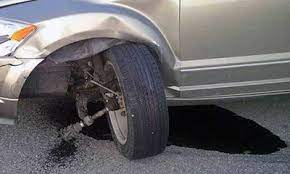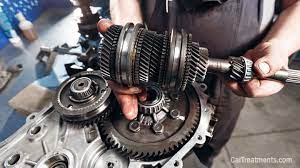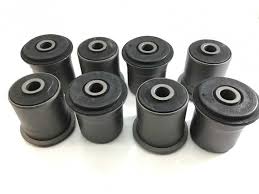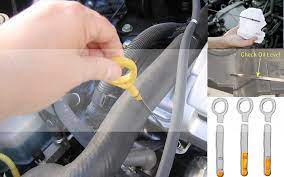A car’s suspension system is a critical part of the vehicle. It keeps you on the road and prevents damage to your wheels and tires, which can lead to costly repairs or replacements. The suspension consists of four major components: springs, struts, shocks/dampers, and bushings. Any one of these can wear out over time due to normal wear-and-tear or heavy use (such as frequent driving on unpaved roads).
Worn or broken shocks or struts
A shock or strut is a device that dampens the impact of bumps on your car’s suspension system. The suspension system serves to keep your wheels on the ground, and it absorbs some of the force of bumps in the road so you don’t feel them as much. When shocks and struts wear out, they can cause car problems like excessive body roll (when one side of the car sways more than usual) or excessive front-to-rear bouncing when going over bumps in the road.
The most common cause for this type of problem is simply age: shock absorbers tend to become less effective over time because they’re made from rubber that degrades with use. If there’s any oil leaking onto your shocks or struts (which would mean they need servicing), that could also lead to failure—and potentially dangerous accidents if you’ve got bad shocks or struts!
Uneven tire wear
If you see tire wear that’s uneven, that could indicate a suspension problem. The tires should be balanced as part of the installation process, but if they weren’t or have become unbalanced since then, it’s possible that your suspension is out of alignment. This can often be remedied by getting an alignment done on the car.
But what if the tires are wearing evenly and there’s no clear reason for their uneven appearance? If this happens to you, it might mean that your car needs new shock absorbers or struts—the components that hold up and control the height of each wheel as it moves over bumps in the road. For example: If one wheel hits a bump while going over it and bounces higher than another wheel with similar weight but different height will bounce (for instance, if one tire is taller than another), then this might cause uneven tread wear patterns across all four tires.
Pulling to one side of the road
If you notice that your car pulls to one side of the road when driving, it could be due to any of the following:
- A bad tire
- An alignment issue
- Bad steering wheel/steering system
- Bad suspension
Vehicle sways or rolls on turns
The suspension system is designed to keep your vehicle level on turns, bumps, braking and acceleration. If the suspension system is not functioning correctly, it can cause your vehicle to sway or roll.
Among other things, swaying or rolling may be caused by one of these problems:
- Broken shock absorbers
- Loose wheel bearings
- Worn suspension springs (spring leafs)
Sometimes an adjustment to the alignment can help correct this problem.
Dips and bounces in the rear of the vehicle when stopping short
When you brake hard, the rear end of your car should not dip or bounce. If it does, you may have a suspension problem. Read Also : Most Information on How Much Platinum is in a Catalytic Converter
If your vehicle dips during braking, it could be one of these issues:
- The anti-roll bar (the bar that connects the front and rear suspension) is too soft or worn out
- Your springs are too soft or worn out
If your car bounces when braking:
- The shock absorbers may need to be replaced
Dips and bounces in the front when stopping short
Dips and bounces in the front of your car when you come to a stop are typically caused by one of the following:
- A problem with your front suspension
- A problem with your front brakes
- A problem with your tires, wheels or suspension mounts
- The shocks/struts might be worn-out and need replacing (or they may need adjusting)
A leaking shock can cause poor handling and stability during cornering or braking, as well as excessive tire wear on rough surfaces like potholes or cobblestones (also known as pavement). The condition usually develops gradually over time—for example, when one wheel begins to bounce more than its counterparts after hitting an obstacle such as a bump in the road—but it can also happen suddenly if one of your tires blows out due to old age or improper inflation pressure (yes, this does happen). Read More : Causes of Vehicle’s Stall When the Brake Is Applied
Bottoms out when going over bumps
If a car is bottoming out, it means that the suspension has been worn out and there’s no more travel left. When this happens, the vehicle can’t cushion impacts and protect its passengers from injury. Bottom-out is dangerous for everyone involved—not just those inside of your car but anyone who might be nearby when you hit a bump in the road.
Signs of bottoming are:
- The ride gets harsher as it travels over bumps
- You feel like your wheels aren’t touching the ground (or pavement)
To avoid bottoming:
- Take your car in for regular inspections to identify any problems early on; this will allow you to repair them before they become serious issues or major expenses.
A good car suspension system can be taken for granted until something goes wrong.
A good car suspension system can be taken for granted until something goes wrong.
When you push a button on your car’s remote, the doors unlock and open to reveal a comfortable interior and all of the tools required to get from point A to point B in style. You may never notice how well-designed your car is unless something goes wrong with its suspension system—and when that happens, it’s easy to realize just how important this component is!
A car’s suspension system is an intricate network of parts that help make sure your vehicle handles smoothly on roads and comfortably around corners. The shocks in particular are vital components because they absorb bumps in the road before they reach passengers inside the cabin of vehicles; adjust tire pressure based on driving conditions; improve fuel economy by minimizing unnecessary rotation; reduce wear-and-tear on tires by keeping them firmly planted against pavement; reduce noise while driving thanks to dampening features like rubber bushings instead of metal bearings; protect occupants from harsh impacts when going over bumps too fast (or hitting curbs), etc..
Conclusion
The car suspension system is one of the most critical components on your vehicle. It helps to keep your wheels in contact with the road and also controls how much you bounce around when going over bumps. If something goes wrong with it, you may feel every little imperfection in the road as if you were driving over a washboard! Keep in mind that problems with your car’s suspension can be difficult to diagnose. Your best bet is to bring it into a shop and have it checked out by an experienced mechanic as soon as you notice any signs of trouble with the ride.







